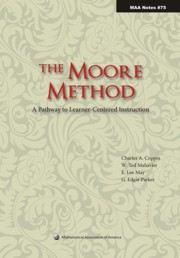Book contents
- Frontmatter
- Contents
- Dedication
- Acknowledgements
- 1 Introduction
- 2 Moore's Moore Method
- 3 What is the Moore Method?
- 4 On Culture
- 5 Development and Selection of Materials
- 6 In the Classroom
- 7 Grading
- 8 Why Use the Moore Method?
- 9 Evaluation and Assessment: Effectiveness of the Method
- 10 Frequently Asked Questions
- Appendices
- About the Authors
- References
- Index
8 - Why Use the Moore Method?
- Frontmatter
- Contents
- Dedication
- Acknowledgements
- 1 Introduction
- 2 Moore's Moore Method
- 3 What is the Moore Method?
- 4 On Culture
- 5 Development and Selection of Materials
- 6 In the Classroom
- 7 Grading
- 8 Why Use the Moore Method?
- 9 Evaluation and Assessment: Effectiveness of the Method
- 10 Frequently Asked Questions
- Appendices
- About the Authors
- References
- Index
Summary
“…no thought, no idea, can possibly be conveyed as an idea from one person to another. When it is told, it is, to the one to whom it is told, another given fact, not an idea. The communication may stimulate the other person to realize the question for himself and to think out a like idea, or it may smother his intellectual interest and suppress his dawning effort at thought. But what he directly gets cannot be an idea. Only by wrestling with the conditions of the problem at first hand, seeking and finding his own way out, does he think.”
—John DeweyRecurring in each author's essay is the theme that the Moore Method is a natural way to teach any subject and that, as such, it has the potential to offer considerable benefits to students—benefits that might be expected to extend beyond those associated with successful lecturing. If one were to seek training for a skill outside the walls of the Ivory Tower such as horseback riding, painting, pottery making, investing, programming, or sewing, odds are good that it would be taught through a hands-on, apprenticeship-style model. Participation breeds interest, something we all wish to instill in our students. Consistent with this model, the authors intertwine their personal beliefs and experiences with an exposition of the benefits of a minds-on, student-as-apprentice-mathematician model.
- Type
- Chapter
- Information
- The Moore MethodA Pathway to Learner-Centered Instruction, pp. 119 - 138Publisher: Mathematical Association of AmericaPrint publication year: 2009

